![]()
![]()
![]()
Use LEFT and RIGHT arrow keys to navigate between flashcards;
Use UP and DOWN arrow keys to flip the card;
H to show hint;
A reads text to speech;
24 Cards in this Set
- Front
- Back
|
What is the relationship cascade from genes to the behavior?
|
Genes --> proteines --> cells --> networks --> brain --> behavior
|
|
|
What are the 3 characteristics of autism spectrum disorder?
|
1. Impairment in language and communication
2. Abnormal sociability/social interactions 3. Restricted interests and repetitive or stereotyped behaviors |
|
|
How common is autism?
|
1/88, more males than females affected
|
|
|
What is ID?
|
IQ of 70 or below
Deficits in adaptive behavior |
|
|
How common is ID?
|
2-3%, more males than females
|
|
|
What causes ID?
|
Non-genetic: fetal alcohol syndrome, premature birth, lack of oxygen at birth....
Genetic: Chromosomal, monogenetic causes Syndromic, non-syndromic, X-linked |
|
|
How many X-linked ID genes have been discovered?
|
More than 100
Maybe this explains why more males are affected? |
|
|
What is special about genes underlying ID?
|
They share biological pathways
For example: Rho GTPase |
|
|
What is the link between ID, autism and epilepsy?
|
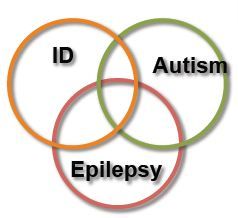
They show high co-morbidity
|
|
|
How does ID affect dendritic spines?
|
Dendritic spine dysgenesis
|
|
|
What are the functions of ID genes?
|
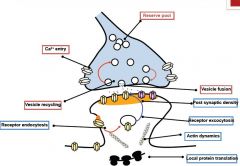
They are linked to synaptic pathways:
1) Reserve vesicle pool 2) Ca2+entry 3) Vesicle recycling 4) Vesicle fusion 5) Post synaptic density 6) Receptor exocytosis 7) Receptor endocytosis 8) Actin dynamics 9) Local protein translation |
|
|
What are the 2 mechanisms important for synaptic plasticity?
|
LTP, LTD
|
|
|
What are the affected cortical connections in autism?
|
Short range, intracortical and long range hyperconnectivity
|
|
|
What kind of rodent models are used, and which tasks are they subject to?
|
Transgenic mice from rare genetic causes
1) Social Interaction tasks * communication (ultrasonic vocalization) * repetitive behavior: grooming 2) Cognitive tasks * water maze, barne's maze * associative learning: fear conditioning |
|
|
LTP/LTD require what at the CA#-CA1 synapse?
|
Insertion/removal of AMPARs (functional plasticity)
Actin polymerization/depolymerization (structural plasticity) |
|
|
What are the functions of Neuroligins/neurexins?
|
They are adhesion molecules maintaining E/I balance
Neuroglins maintain the balance between excitatory and inhibitory input |
|
|
What is Fragile X syndrome?
|
Loss of function of FMRP (protein translator repressor --> excessive protein synthesis)
Single most prevalent cause of autism X-linked Spine dysgenesis |
|
|
What is Rett syndrome (MECP2)?
|
Loss of function of MECP2 (methyl CpG binding protein 2, transcription repressor)
Typical hand wringing stereotypy Slowed growth, loss of communication/thinking abilities, movement and coordination impaired, seizures X-chromosome: only females affected |
|
|
What is the interaction between the effects of inhibitory and excitatory neurons?
|
They have competitive effects on the nerve cell
|
|
|
The pathophysiology of fragile X
|
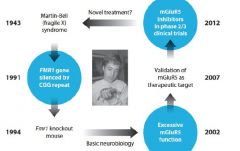
Synaptic abnormalities
|
|
|
What is the Kleefstra syndrome?
|

Single gene mutations in either EHMT1, MBD5, MLL3..
Severe ID, little speech, hypotonia Eu-HMTase1 is a H3-K9 methyltransferase H3K9me2/3 is a repressive marker for transcription EHMT1+/- mice: developmental delay, impaired novel object recognition |
|
|
What are 2 methods to analyse dendrite structure?
|
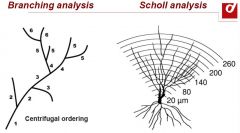
branching analysis and scholl analysis
Ehmt1+/- have less developed spines (surface, #branches and endings etc..) Scholl analysis: fewer number of intersections |
|
|
Why is there increased PPF (pair pulse facilitation) in Ehmt1+/- mice?
|
The increase is due to a decrease in presynaptic release probability.
|
|
|
WHat about the miniature excitatory psot-synaptic current in EHMT1+/-?
|
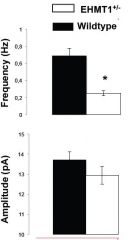
They are decreased
|

